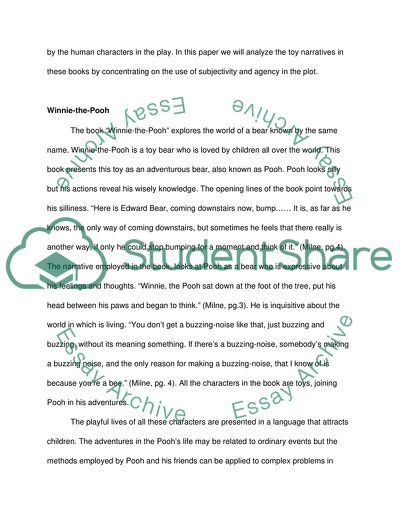Cite this document
(The Representation of Subjectivity and Agency in the Toy Narratives Assignment, n.d.)
The Representation of Subjectivity and Agency in the Toy Narratives Assignment. https://studentshare.org/literature/1717824-the-representation-and-the-exploration-of-subjectivity-and-agency-in-the-toy-narrative-in-the-works-of-1-aamilnes-winnie-the-pooh-2-ursuladubosarskys-abyssinia-3-rumergoddens-the-dolls-house
The Representation of Subjectivity and Agency in the Toy Narratives Assignment. https://studentshare.org/literature/1717824-the-representation-and-the-exploration-of-subjectivity-and-agency-in-the-toy-narrative-in-the-works-of-1-aamilnes-winnie-the-pooh-2-ursuladubosarskys-abyssinia-3-rumergoddens-the-dolls-house
(The Representation of Subjectivity and Agency in the Toy Narratives Assignment)
The Representation of Subjectivity and Agency in the Toy Narratives Assignment. https://studentshare.org/literature/1717824-the-representation-and-the-exploration-of-subjectivity-and-agency-in-the-toy-narrative-in-the-works-of-1-aamilnes-winnie-the-pooh-2-ursuladubosarskys-abyssinia-3-rumergoddens-the-dolls-house.
The Representation of Subjectivity and Agency in the Toy Narratives Assignment. https://studentshare.org/literature/1717824-the-representation-and-the-exploration-of-subjectivity-and-agency-in-the-toy-narrative-in-the-works-of-1-aamilnes-winnie-the-pooh-2-ursuladubosarskys-abyssinia-3-rumergoddens-the-dolls-house.
“The Representation of Subjectivity and Agency in the Toy Narratives Assignment”. https://studentshare.org/literature/1717824-the-representation-and-the-exploration-of-subjectivity-and-agency-in-the-toy-narrative-in-the-works-of-1-aamilnes-winnie-the-pooh-2-ursuladubosarskys-abyssinia-3-rumergoddens-the-dolls-house.


